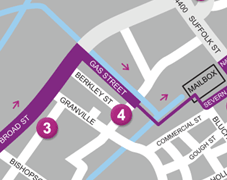
Photograph of Birmingham Canal
[Local Studies: WK/B11/6854]
|

Birmingham manufacturer of guns for export
[LSH: Trade Card 633]

Tobacco, cigar and snuff importer and manufacturer
[LSH: Trade Card 251]
|
Birmingham, Industry and Slavery
Built in the late 18th century, the Gas Street Basin is the meeting place of the Birmingham Main Line and the Worcester and Birmingham canals. These canals allowed the town to import and export a huge variety of metals and goods.
At this period, the transatlantic slave trade had reached its peak. Selling guns, chains and other products (often transported by canal) was just one way in which Birmingham’s economy heavily relied on slavery.
In response to the continuing transatlantic slave trade, Joseph Sturge helped to form ‘The Birmingham Anti-Slavery Society’ in 1826.
This campaign group worked alongside ‘The Birmingham Ladies Society For The Relief of Negro Slaves’ and a number of black abolitionists who visited Birmingham, such as Frederick Douglass (who gave a speech here in 1846).
Whilst some critics argued slavery abroad was needed to support jobs at home, these activists argued slavery was morally indefensible. Sturge refused all products connected with slave labour.
|

Directions
Head off Broad street onto Gas Street (the turning is opposite the pub called ‘The Brasshouse’). Go through the archway on the left onto the canal. Continue to walk onward towards the Mailbox building.
|